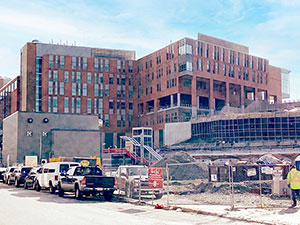
Gilman Square’s Green Line T-stop is bringing the local community together to discuss its optimal use and ensure the common good for all who may be affected by its presence. ~Photo by Bobbie Toner
By Eliza Billingham
Imagining the subway like a river, most people think of a subway stop like a small, sudden clearing on the bank; an easy point of access and transition. But the wise know that a subway stop is more like a water wheel, a point of power and productivity for those who control it. The issue then becomes who harnesses the power for whom.
Somerville and its residents are wise to the power that the Green Line Extension (GLX) is bringing to their city. Gilman Square is a new Green Line stop being built in the heart of Somerville, an area previously underserved by public transportation. The new stop will be right next to Somerville High School, the public library and city hall. It is being built next to city-owned land with unique zoning opportunities. If harnessed well, Gilman Square can be transformed from a single transit stop into a neighborhood focal point that powers the entire community.
The new Gilman Square stop is being built between School Street and Medford Street, right next to the Reid and Murdock building site (also called the Homans building), which is owned by the city. Once the station is complete, this property is set to become a lucrative site for developers. As the owner of the plot, the city is in a powerful position to leverage developers into providing affordable housing, public amenities or green space near the T stop, should it decide to do so.
Gavin Robb is a Somerville resident, architect and educator. He has been carefully tracking Somerville’s vision for the GLX. He will teach a course about the design process of Gilman Square for the 2022 spring semester at the Rhode Island School of Design.
Robb explains that at this specific stop, the city can make zoning restrictions that “incentivize development the way the city wants.” If Somerville decides to sell the Reid and Murdock building, it can set its own ground rules when soliciting proposals from developers. Those ground rules, Robb argues, ought to be informed by the community’s needs and requests.
“Neighborhood is so relevant,” he says. “There is a way that these resources can help everyone.”
To service everyone, the city needs to know what residents want.
In October 2021, Somerville announced the formation of a Civic Advisory Committee to “bring together a diverse group of Gilman Square neighborhood leaders” and “bring as many voices into the process as possible … to synthesize community feedback,” according to Somerville’s Gilman Square Plan Implementation. A similar committee was created during the redevelopment in Union Square. As the council materializes, Robb hopes the city will take their concerns seriously.
This is the way that a community harnesses a T stop to power a neighborhood center. The city can change the zoning around the T stop, allowing for commercial development and creating a central hub. Residents are talking about attracting a grocery store or a theater. Previously, this area had “no sense of central space,” Robb says, “but this train line will change that dynamic.” The station provides an anchor spot for retail and housing, as well as streamlines the entire city’s flow to the library and city hall.
Other residents are making sure the city advocates for accessible amenities as they consider new developments. Colin Killick, Executive Director of Disability Policy Consortium in Massachusetts noticed a staircase connecting the proposed Gilman Square stop to street level. It took showing up to city meetings again and again to explain the thoughtlessness of the stairs.
“There was no outreach to the disability community,” Killick says. “I had to show up, I had to be loud.”
Eventually, the city committed to making the T stop more accessible for people with disabilities. Then councilwoman, now Mayor-elect Katjana Ballantyne was one of the people who made a promise to provide more equitable access.
“To their credit, they made the commitment,” Killick says. “But we won’t know for sure until the station is open.”
Amenities that are equitable, affordable and advantageous for the whole neighborhood take careful planning and diverse perspectives. Community involvement is slow and fraught with mistakes. Constructing Gilman Square to benefit the surrounding community is a test of Somerville’s expressed commitment to “an accessible, mixed-income, multi-cultural city.”
Robb, architect and educator, shares a borrowed metaphor that guides his thinking of development. He hopes it will guide Somerville’s planning as well.
Said Robb, “If there’s a lot of money coming into a community, it can happen two ways: it can come in like a big wave and wash everyone away, or it can come in and lift everybody up. The difference is how the flow is managed.”















Reader Comments